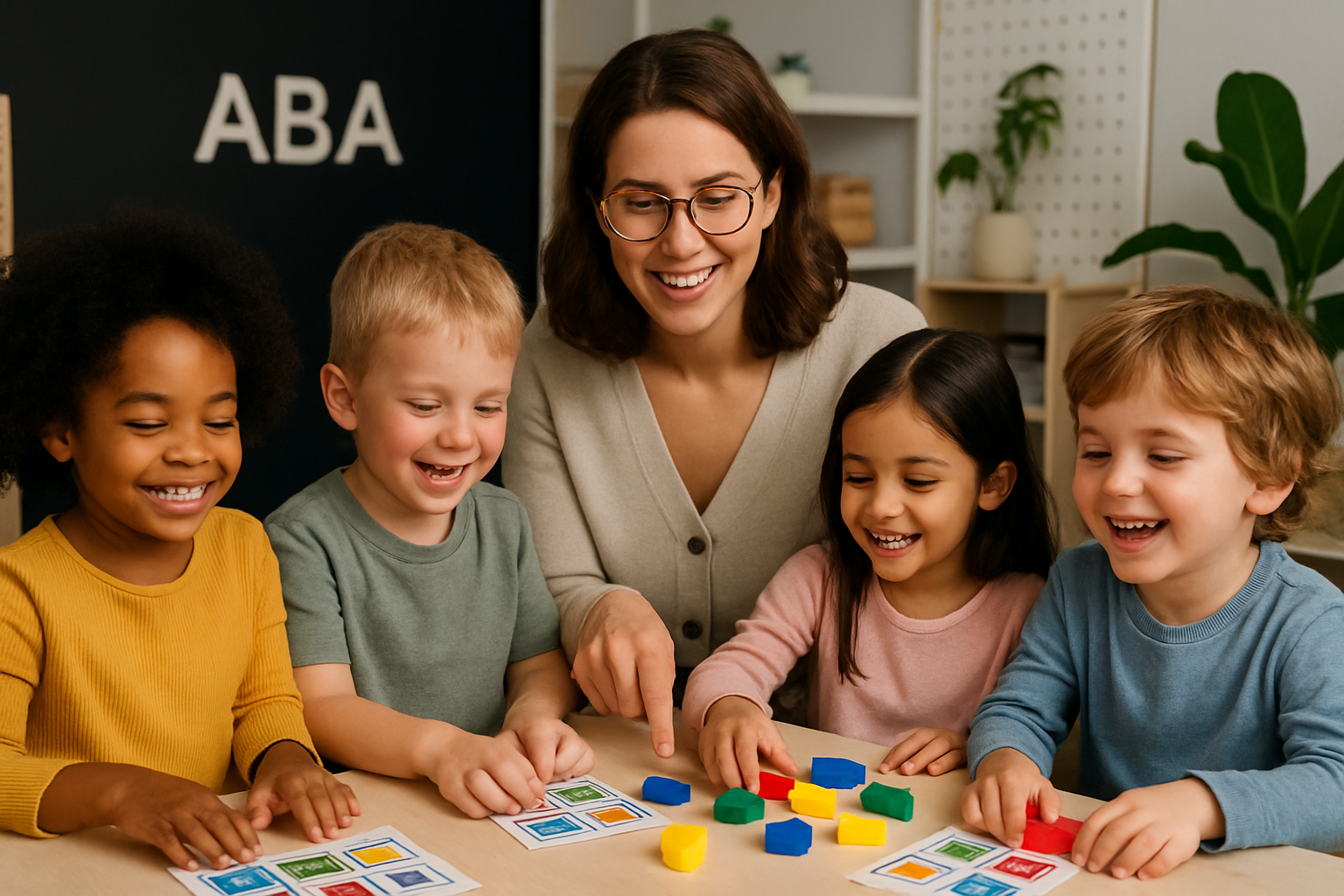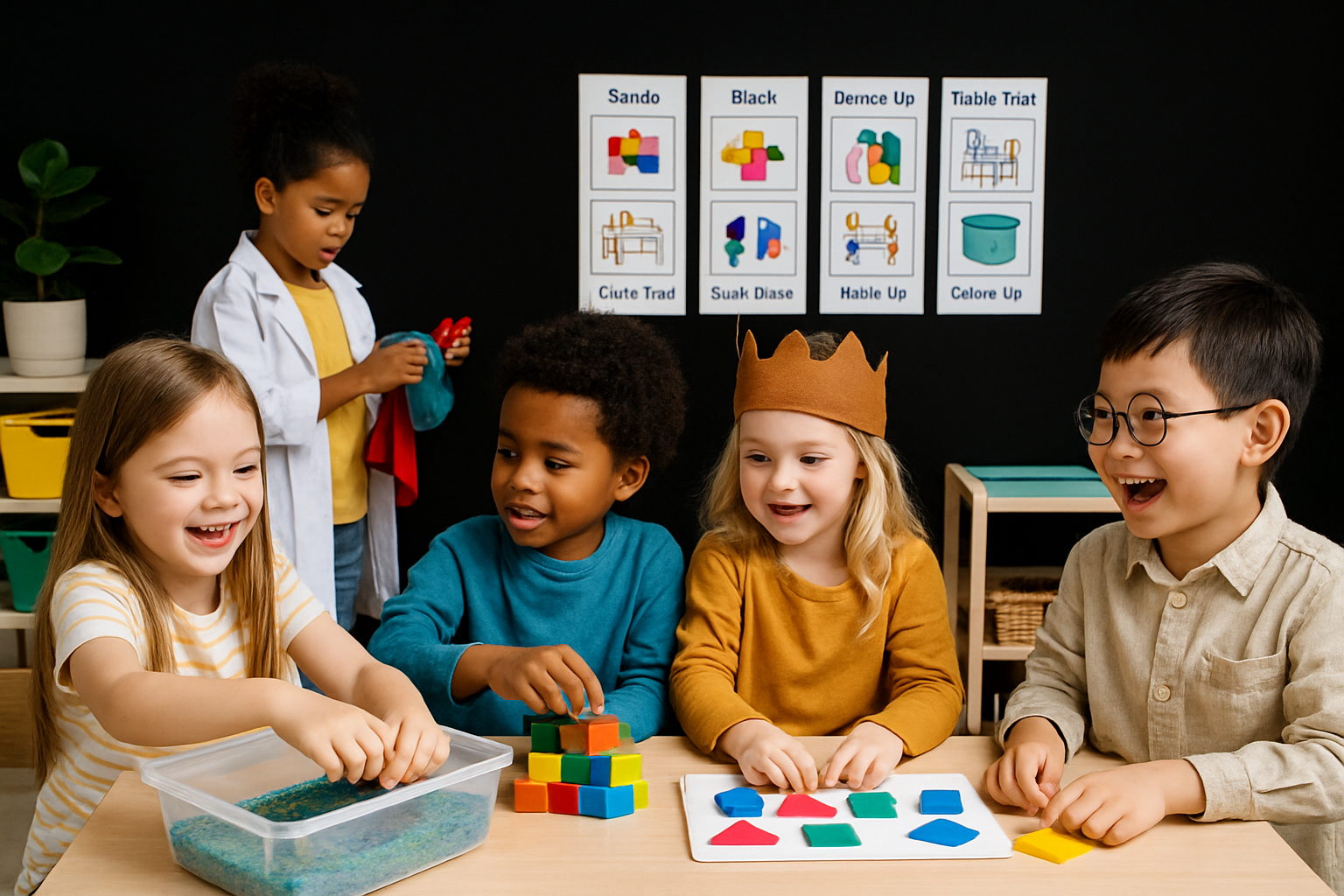Engaging ABA Activities to Boost Learning and Independence
Parents and educators understand that helping kids build essential skills is critical, particularly in the evolving landscape of 2025. As the world changes, the methods we use to support children’s growth and learning must adapt. Applied Behavior Analysis (ABA) activities are at the forefront, boosting crucial skills like independence, communication, and social abilities, especially for children with autism. These proven, effective strategies make learning both impactful and enjoyable, whether used in modern classrooms or at home.
This article details the 10 best ABA activities for kids in 2025. You'll discover practical, evidence-based ideas designed to empower families, therapists, and teachers to facilitate real, measurable progress every day. Prepare to uncover new, engaging ways to transform daily routines and skill-building with simple activities you can implement immediately.
Understanding ABA Therapy and Its Impact on Child Development
ABA activities have become a core approach for helping children with autism and other developmental needs thrive. By concentrating on evidence-based strategies and the power of positive reinforcement, these activities effectively shape behavior in ways that are meaningful and lasting. Let's examine precisely how modern ABA activities are changing children's lives.

THE FOUNDATIONS OF ABA THERAPY: SKILL BUILDING FOR AUTISM
Applied Behavior Analysis (ABA) is a highly effective, evidence-based approach designed to help children learn new skills by carefully breaking down complex tasks into smaller, manageable steps. ABA activities fundamentally rely on positive reinforcement to encourage progress and celebrate successes, ensuring each small achievement becomes a crucial stepping stone toward bigger goals.
Board Certified Behavior Analysts (BCBAs) are responsible for designing and overseeing personalized therapy plans, guaranteeing that every child's specific needs are met. The inherent flexibility of ABA allows it to be tailored for various learning styles and diverse developmental levels. The CDC recognizes ABA as one of the most effective interventions for autism, with numerous studies demonstrating significant improvements in essential daily routines and communication abilities.
To dive deeper into the science and structure behind these powerful methods, feel free to explore the Basics of Applied Behavior Analysis.
Why Modern ABA Activities Matter in 2025
In 2025, the significance of ABA activities continues to expand due to the rising rate of autism diagnoses and the critical emphasis on early intervention. An increasing number of families are actively seeking flexible options, including home-based and virtual ABA therapy, a trend heavily accelerated by the recent pandemic. This shift is driving powerful innovation in therapy delivery, making it much easier for parents to engage actively.
Modern ABA activities prioritize building key areas like independence, effective communication, and social-emotional skills. Recent research underscores that interactive and engaging approaches lead to superior outcomes for kids. Technology integration, such as specialized apps and sensory-friendly tools, makes these activities highly accessible and adaptable. Furthermore, parent-led sessions, utilizing structured and easy-to-implement activities, are becoming increasingly popular and effective.
Key Benefits of ABA Activities for Kids with Autism
Implementing the right ABA activities can profoundly transform a child's capacity to communicate and interact with their surrounding world. Some of the core benefits include:
- Improved communication and vital language development.
- Enhanced social interaction and appropriate play skills.
- Greater independence in self-care and daily routines (e.g., dressing, brushing teeth).
- Reduction of challenging behaviors through consistent positive reinforcement.
- Better school readiness and essential academic skills.
- Emotional regulation and effective coping strategies.
For instance, many children quickly master self-care tasks, like complete hand-washing routines, through consistent, structured ABA practice, significantly boosting their confidence and autonomy.
How to Choose the Right ABA Activities and Interventions
Selecting the best ABA activities for your child begins with thoroughly understanding their current age, specific interests, and ultimate developmental goals. It is highly beneficial to consult with therapists or educators for expert guidance and to select activities that are inherently fun and easy to adapt.
Focus on activities that incorporate visual supports and provide clear, simple instructions. Successfully balancing structured routines with creative play keeps children highly engaged while promoting effective learning. Utilizing your child's favorite characters or themes can further personalize the experience. For example, creating a daily routine chart based on a child’s favorite cartoon character can make the process enjoyable and significantly more effective.
THE 10 BEST ABA ACTIVITIES FOR KIDS IN 2025
Are you searching for fresh, effective ABA activities for kids in 2025? Here are the top 10 methods that make learning fun, practical, and deeply engaging for children of all abilities. These ABA activities are specifically designed to foster communication, independence, and social skills in authentic, real-world settings.

1. Visual Schedule Routines
Visual schedules are a cornerstone of ABA activities. Using picture-based charts, children learn to manage daily living skills like brushing teeth or getting dressed. These ABA activities reduce anxiety by making routines predictable and empowering kids to move icons as tasks are completed.
- Picture schedules for morning, bedtime, or transitions.
- Movable icons for interactive engagement.
- Time challenges to add excitement.
Positive reinforcement, like stickers or tokens, motivates participation. Visual schedules can be used at home, in classrooms, or during therapy sessions. For example, a morning routine chart with Velcro icons lets children “check off” each step, boosting independence and confidence.
2. Cooking and Snack Preparation
Cooking is one of the most practical ABA activities for building life skills. Children practice sequencing, following instructions, and kitchen safety. Fine motor skills are developed through measuring, pouring, and mixing.
- Simple recipes like sandwiches or fruit salads.
- Choices to encourage decision-making.
- Communication practice: asking for help or ingredients.
Creativity flourishes when kids decorate food. Try a “Make Your Own Pizza” day, where children select and layer toppings. These ABA activities support independence and foster a sense of achievement as children enjoy their creations.
3. Role-Playing Social Scenarios
Role-playing is a powerful approach in ABA activities for teaching social skills. Simulate real-life situations like doctor visits, grocery shopping, or playdates to practice greetings, turn-taking, and expressing needs.
- Use props and costumes to capture interest.
- Practice problem-solving in social contexts.
- Reinforce appropriate responses with praise.
Reducing anxiety about unfamiliar situations is key. For instance, set up a pretend grocery store with play money, allowing kids to “shop,” interact, and learn essential social behaviors in a safe, supportive environment.
4. Interactive Chores Challenge
Transforming chores into ABA activities makes learning responsibility fun. Turn laundry sorting or dishwashing into games, using timers or upbeat music to boost motivation.
- Immediate rewards for completed tasks.
- Teamwork or friendly competition.
- Adapt chores to match developmental levels.
A “Tidy-Up Treasure Hunt” is a favorite: hide small rewards around the room and encourage kids to clean up as they search. These ABA activities teach time management while making daily routines enjoyable.
5. Personal Hygiene Adventures
Personal hygiene routines are essential ABA activities for daily living. Make them playful with toothbrushing contests or bath-time games.
- Visual cues and timers for brushing duration.
- Sensory-friendly soaps or toothbrushes.
- Songs or stories to reinforce steps.
Offer rewards for consistent habits. For example, “Hand-Washing Wizard” uses color-changing soap and a fun song to teach proper technique, turning a routine task into an adventure.
6. Color and Shape Sorting Games
Sorting is a classic ABA activities approach for developing cognitive and categorization skills. Use blocks, buttons, or cards to practice sorting by color and shape.
- Matching activities for visual discrimination.
- Scaffold difficulty by adding new categories.
- Calm, focused activity for sensory regulation.
The “Rainbow Sorting Race” uses colored cups and objects for a fast-paced, engaging experience. These ABA activities are simple to adapt and can be made more challenging as skills grow.
7. Emotion Identification and Expression Activities
Teaching emotion recognition is crucial in ABA activities. Use cards, mirrors, or emojis to help children identify and label feelings.
- Role-play scenarios involving emotions.
- Art projects to draw or model facial expressions.
- Coping strategies for emotional regulation.
Play “Feelings Bingo” with emotion faces, encouraging kids to match and discuss different feelings. These ABA activities support emotional literacy and help children communicate more effectively.
8. Turn-Taking and Sharing Games
Turn-taking is a foundational skill in many ABA activities. Play board games, puzzles, or ball games to practice patience and cooperative play.
- Visual cues to signal whose turn it is.
- Praise for successful sharing and waiting.
- Scaffold with simpler games for younger children.
Try “Pass the Parcel” with small rewards hidden in layers. These ABA activities build social confidence and set the stage for positive peer interactions. For more ideas on nurturing social skills, check out Nurturing social skills in ASD.
9. Sensory Bin Exploration
Sensory bins are engaging ABA activities perfect for tactile play and sensory processing. Fill bins with rice, beans, sand, or water, and hide small objects for search-and-find games.
- Encourage descriptive language and requesting.
- Adapt themes (beach, farm, kitchen) for variety.
- Support calming and focus.
A “Dinosaur Dig” sensory bin lets kids excavate buried dinosaurs, combining fun with fine motor practice. These ABA activities are easy to set up and endlessly customizable.
10. Technology-Assisted ABA Activities
Modern ABA activities often leverage technology for interactive learning. Tablets and computers offer apps for skill-building, while AAC tools support non-verbal children.
- Digital games reinforce ABA concepts.
- Track progress with dashboards for parents and therapists.
- Balance screen time with hands-on activities.
The “Emotion Matching” app, featuring animated faces, helps children practice emotion identification in a dynamic, rewarding way. Technology-assisted ABA activities can supplement hands-on learning and keep kids motivated.
IMPLEMENTING ABA ACTIVITIES AT HOME AND SCHOOL
Supporting children’s growth with ABA activities can be both rewarding and manageable when you have the right strategies in place. Whether at home or in a classroom, building consistency and engagement is key to success.

PRACTICAL TIPS FOR PARENTS AND EDUCATORS: MAXIMIZING ABA SUCCESS
Consistency is crucial for making ABA activities effective. Start by setting up clear routines and environments. Use visual supports like charts or cue cards to help children anticipate what comes next.
- Incorporate your child’s favorite interests into activities.
- Begin with simple steps, then gradually add complexity (shaping).
- Collaborate with therapists to adjust activities as needed.
A daily routine board in the kitchen can keep everyone on track. For more examples of skills developed through ABA, see Skills developed through ABA.
Reinforcement and Motivation Strategies
Reinforcement keeps ABA activities motivating and fun. Offer immediate, meaningful rewards such as praise, tokens, or a favorite activity. Use a token system for larger accomplishments.
- Mix up rewards to maintain interest (reinforcer sampling).
- Gradually fade out rewards to build internal motivation.
- Track and celebrate every milestone.
Sticker charts for completed routines work wonders. Remember, celebrating small wins encourages children to keep trying new ABA activities.
Adapting Activities for Different Ages and Abilities
Every child is unique, so ABA activities should be tailored to their developmental level. Adjust the complexity of each task and allow room for creativity.
- Offer choices to boost engagement.
- Use larger or tactile materials for younger children.
- Scaffold social games with visual cues.
Ask for feedback from your child to personalize activities further. With thoughtful adaptations, ABA activities become accessible and enjoyable for all ages.
Collaborating with ABA Professionals
Working with professionals ensures ABA activities meet your child’s specific needs. Consult with Board Certified Behavior Analysts (BCBAs) for customized plans.
- Request parent training for at-home strategies.
- Share observations and progress with therapists.
- Integrate therapy goals into everyday routines.
Use a home-school communication log to keep everyone informed. Teamwork between families, teachers, and therapists makes ABA activities more effective and meaningful.
MEASURING PROGRESS AND ENSURING SUCCESS
Tracking progress is essential when using ABA activities to help children build new skills. With the right strategies, families and educators can see real growth, celebrate milestones, and adjust plans for even better outcomes.

TRACKING PROGRESS AND ENSURING LONG-TERM SUCCESS
Tracking Skill Acquisition with Data
Consistent data collection is the backbone of success with ABA activities. Use simple tools like sticker charts, tally sheets, or digital apps to track each skill your child is working on. Note how often a child completes a task independently, needs help (prompting), or shows new behaviors.
Regular review of this data reveals patterns. It helps identify which ABA activities are making the most impact and where extra support is needed. For a deeper dive into how evidence-based interventions drive progress, explore the Comprehensive ABA Interventions Meta-Analysis.
- Use weekly progress reviews with your child.
- Display achievements with stickers or graphs.
- Adjust activities based on trends you observe.
Overcoming Common Challenges
Challenges are part of every learning journey. If your child resists certain ABA activities, try making them more playful or meaningful. Break tasks into smaller, manageable steps (task analysis), and provide clear visual or physical prompts to support learning.
Patience is key. Celebrate even the smallest victories to keep motivation high. If issues persist, connect with a professional for tailored guidance.
- Make activities fun and engaging.
- Use prompts and supports as needed.
- Introduce new activities gradually.
Fostering Generalization and Maintenance
The real power of ABA activities lies in helping children use their new skills across different settings (generalization). Practice skills at home, school, and in the community. Invite parents, siblings, and peers to participate so the child learns to generalize behaviors.
Research shows that interactive ABA activities can improve social and emotional skills, especially when practiced in varied environments. Read more on the Effectiveness of ABA in Enhancing Emotional-Social Skills.
- Reinforce skills in real-life situations.
- Schedule regular review sessions.
- Encourage child-led activity initiation.
The Role of Family and Community Support
Success with ABA activities expands when families and communities work together. Siblings and peers can join in activities, supporting social learning and inclusion. Create a supportive atmosphere that values progress over perfection.
Share your experiences and resources with other families. Connect with local support groups or organize inclusive community events to extend the benefits of ABA activities to more children.
- Involve family members in daily routines.
- Join or start a local support group.
- Advocate for inclusive events at school or in the neighborhood.
FUTURE TRENDS IN ABA ACTIVITIES FOR KIDS
The future of ABA activities is brighter than ever, thanks to constant innovation and a growing commitment to inclusivity. As we look ahead, families and professionals can expect new tools, deeper social-emotional focus, and broader access for all children. Let’s explore the trends shaping ABA activities in 2025 and beyond.
FUTURE TRENDS IN ABA ACTIVITIES FOR KIDS
Innovations in ABA Tools and Resources
Technology is transforming ABA activities at lightning speed. In 2025, expect to see digital apps for skill-building and remote therapy sessions becoming routine. AI-powered platforms are personalizing activities to each child’s needs, tracking progress with impressive accuracy. For instance, AI-Augmented Behavior Analysis for Precision Treatment demonstrates how artificial intelligence can help tailor interventions and monitor outcomes in real time.
Families are also seeing more sensory-friendly materials and adaptive tools. Personalized activity kits and even virtual reality (VR) are making learning more engaging. Imagine a child practicing social skills through a VR playdate or using an app to reinforce daily routines—these are just a few ways ABA activities are evolving in the digital age.
Emphasis on Social-Emotional Learning (SEL)
A growing trend in ABA activities is the integration of social-emotional learning (SEL). Mindfulness exercises, emotion identification games, and group activities are becoming central. Kids are now practicing empathy and perspective-taking through role-play and collaborative games.
Schools are joining forces with therapists to offer SEL programs that nurture emotional intelligence. For example, group emotion charades or yoga sessions help children recognize and manage feelings in a safe, supportive setting. This focus ensures ABA activities not only teach practical skills but also foster lifelong emotional resilience.
Expanding Access and Inclusivity
Inclusivity is at the heart of modern ABA activities. Resources are expanding for non-verbal, minimally verbal, and culturally diverse children. Bilingual visual schedules, multicultural social stories, and adaptive communication tools are helping all kids participate meaningfully.
Community partnerships are making ABA activities more accessible in underserved areas. Local events, like sensory play days, encourage families to connect and share strategies. By embracing diversity and removing barriers, ABA activities are empowering every child to succeed, no matter their background or abilities.
If you’re excited to try these ABA activities and want guidance tailored to your child’s unique strengths, you’re not alone—we know the journey can feel overwhelming at times. At Silveira Behavior Consultants, we’re here to help you turn these strategies into meaningful progress, whether you’re working on social skills, daily routines, or building independence. If you have questions or want to see how our team can support your family’s goals with personalized ABA therapy, don't hesitate to Inquire About Services. Together, we can make learning engaging and empowering for your child.





